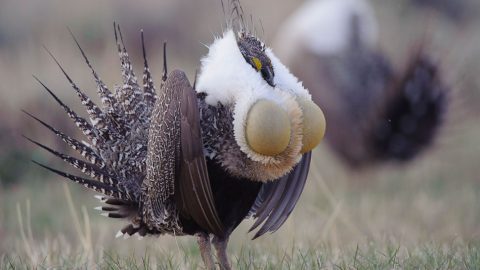Preserving Isolated Sage-Grouse Populations Depends on Habitat Connectivity
January 30, 2017

Editor’s note: The following research summary describes a new article in The Condor: Ornithological Applications, a journal of The American Ornithologists’ Union, and was provided by the Central Ornithology Publication Office. For more on Greater Sage-Grouse conservation, see Last Grouse Standing: Can Birds and Industry Coexist in the Western Sage Lands? from the Spring 2015 issue of Living Bird magazine.
Greater Sage-Grouse depend on large, intact tracts of the sagebrush habitat. Current sage-grouse conservation plans focus on protecting selected “priority areas,” but these areas vary in size and proximity to each other—will they be able to sustain thriving, interconnected populations over time? A new study from The Condor: Ornithological Applications evaluates this approach.
Small, isolated populations of sage-grouse are especially vulnerable to threats like wildfires and West Nile virus, and genetic diversity declines if birds don’t have the ability to occasionally interbreed with other groups. This study provides land managers with a new way to rank priority areas based on their contributions to connectivity.
Using a statistical technique known as graph theory, Michele Crist, Steven Knick, and Steven Hanser of the U.S. Geological Survey examined how the spatial arrangement of priority areas might affect their ability to function as an interconnected network of reserves. They found that of the three networks of sage-grouse priority areas—the Washington network, the Bi-State Network comprising California and Nevada, and the Central network, which is the largest and includes parts of ten states—only the priority areas of the Central network had a high degree of connectivity, and even there connectivity was dominated by a small number of large, centrally located sites.
Related Stories
“Graph theory is a way to describe a network based on sets of nodes and their connections with others. The network’s characteristics reveal a lot of information about how that network functions,” says Knick. “For example, importance within the network can be inferred from being large and having many connections or by connecting different groups within the network. The analysis is commonly applied to understand social networks.”
“Managing the differing ecologies of a landscape-scale species presents many challenges even in a perfect world of unlimited resources and complete agreement amongst all associated stakeholders. As that is almost never the case, having studies such as the one presented here is essential to inform sound, science-based decisions,” according to Pat Deibert, National Sage-Grouse Conservation Coordinator for the U.S. Fish and Wildlife Service. “This exploration of connectivity and inferences for the long-term viability of prioritizing landscapes for conservation of the Greater Sage-Grouse is extremely valuable for assessing the efficacy of the current management strategy and informing decisions and appropriate adjustments in the future.”
About the journal: The Condor: Ornithological Applications is a peer-reviewed, international journal of ornithology. It began in 1899 as the journal of the Cooper Ornithological Club, a group of ornithologists in California that became the Cooper Ornithological Society, which merged with the American Ornithologists’ Union in 2016 to become the American Ornithological Society.
Reference
Crist, M.R., et al. 2017. Range-wide connectivity of priority areas for Greater Sage-Grouse: Implications for long-term conservation from graph theory. The Condor 119 (1): 44-57.


All About Birds is a free resource
Available for everyone,
funded by donors like you







